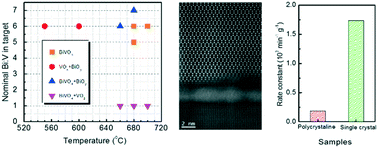Target stoichiometry and growth temperature impact on properties of BiVO4 (010) epitaxial thin films
Abstract
The effects of target stoichiometry and growth conditions on the structure and properties of the monoclinic bismuth vanadate (BiVO4) (010) epitaxial films created using pulsed laser deposition were studied systematically. It is shown that phase-pure monoclinic BiVO4 epitaxial films were fabricated from a nonstoichiometric target with a bismuth/vanadium (Bi : V) ratio of 6 at 680 °C. The three-dimensional and adsorption-controlled growth process was confirmed using X-ray diffraction and atomic force microscopy. The valence states of Bi3+ and V5+ were determined from the results of X-ray photoelectron spectroscopy (XPS), indicating that the BiVO4 film has substantial stoichiometry. The results of the valence band XPS indicated that the Bi 6s energy level of the BiVO4 (010) film was located much deeper than that of the polycrystalline sample. The direct optical band gap of the BiVO4 film was found to be 2.59 eV. The photocatalytic oxidization activity of the single crystal BiVO4 film for rhodamine B degradation is about one order of magnitude higher in comparison with the polycrystalline sample, indicating that the nanostructured BiVO4 film is a promising material for obtaining better photocatalytic activity.



 Please wait while we load your content...
Please wait while we load your content...